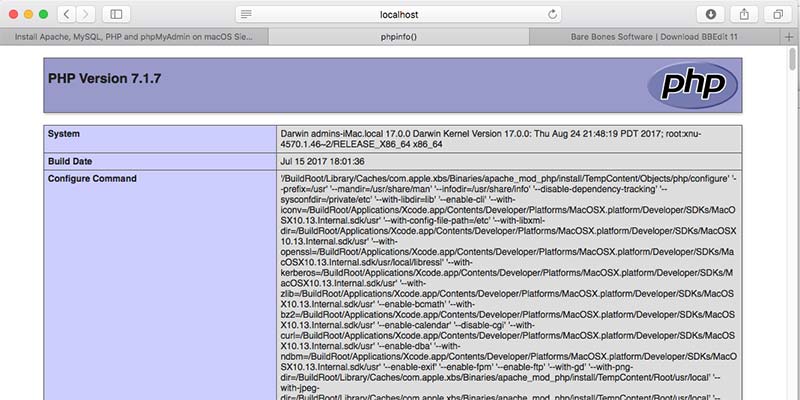
macOS Mojave ships with PHP 7.1, High Sierra 7.1, Sierra ships with PHP 5.6, OSX 10.11 El Capitan with PHP 5.5.x, there is an easy upgrade method to either the latest PHP version 7.3 or 7.2 or you can also go back to the older stable version 5.6.
PHP 7.3.10 - Server-side, cross-platform, HTML embedded scripting language. Download the latest versions of the best Mac apps at safe and trusted MacUpdate. I recently upgraded to Mac OS X Yosemite. It seems Mac OS X Yosemite makes my original post on installing Apache, PHP, and MySQL on Mac OS X obsolete. Specifically, Yosemite includes Apache 2.4. This post is a complete update for installing Apache, PHP, and MySQL on Mac OS X Yosemite. A reminder that Mac OS X runs atop UNIX. XAMPP for Mac is a completely free, easy to install Apache distribution containing MySQL, PHP, and Perl. The XAMPP open source package has been set up to be incredibly easy to install and to use. Download XAMPP Offline Installer Setup!
In this section, you will get SQL Server 2017 running on Docker. After that you will install the necessary dependencies to create PHP apps with SQL Server. Step 1.1 Install SQL Server. In order to run SQL Server on your Mac, we are going to use the SQL Server on Linux Docker Image. For this, you need to install Docker for Mac. With Antivirus for Mac Ensure Complete Protection to your Mac book against adwares, spyware and malware attacks. Download Mac Virus removal for Free!
PHP versions 5.5 and older are now considered end of life, with 5.6 and version 7.1 these will be the end of life in December 2018.
With the new macOS Mojave & High Sierra they already come shipped with PHP7.1.
The latest PHP version in this guide is from this PHP Packaged site which is being maintained for macOS and is known as a reliable source.
Php 7.2 For Mac
Download and Install PHP 7.3, 7.2, 7.1 or 7.0
Open Terminal and run…
or for 7.3
or for 7.2
or for 7.1
or for 7.0
You get a warning error for if the php is a newer version
The version is filed in /usr/local/php5 – Test the php version by creating a php file named phpinfo.php in your web root with the single function:
Browse to that file and see the version displayed.
If instead you just want to just update to the latest 5.6 PHP…
Open the Terminal and issue one command –
That’s it! One line command in the terminal, this will download and install PHP5.6 in:

Apache Configuration
For either PHP version install 7.3, 7.2, 7.1 or 5.6 etc, the install script will also disable the previous PHP5.5 if it was enabled in the Apache configuration file /etc/apache2/httpd.conf . The new version is enabled in Apache right off the bat, the new install will comment out the older PHP module.
It will load the new PHP version via the /etc/apache2/other/+php-osx.conf file.
So to reverse the behavior uncomment the older PHP module in httpd.conf and remove the new config in other.
- PHP Tutorial
- Advanced PHP
- PHP Form Examples
- PHP login Examples
- PHP AJAX Examples
- PHP XML Example
- PHP Frame Works
- PHP Design Patterns
- PHP Function Reference
Phpstorm Mac
- PHP Useful Resources

- Selected Reading
Mac users have the choice of either a binary or a source installation. In fact, your OS X probably came with Apache and PHP preinstalled. This is likely to be quite an old build, and it probably lacks many of the less common extensions.
However, if all you want is a quick Apache + PHP + MySQL/PostgreSQL setup on your laptop, this is certainly the easiest way to fly. All you need to do is edit your Apache configuration file and turn on the Web server.
So just follow the following steps −
Install Php For Mac
Open the Apache config file in a text editor as root.
Edit the file. Uncomment the following lines −
You may also want to uncomment the <Directory /home/*/Sites> block or otherwise tell Apache which directory to serve out of.
Restart the Web server
Open a text editor. Type: <?php phpinfo(); ?>. Save this file in your Web server's document root as info.php.
Start any Web browser and browse the file.you must always use an HTTP request (http://www.testdomain.com/info.php or http://localhost/info.php or http://127.0.0.1/info.php) rather than a filename (/home/httpd/info.php) for the file to be parsed correctly
You should see a long table of information about your new PHP installation message Congratulations!